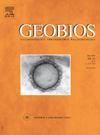中新世早期产于新西兰的似海鸥的鸟(鸻形目:蛱蝶科)
IF 1.6
4区 地球科学
Q2 PALEONTOLOGY
引用次数: 0
摘要
滨鸟科包括海鸥、燕鸥、掠食鸟和鹬,它们今天主要栖息在世界各地的近岸海洋环境中。在法国saint - gsamrade -le- puy的渐新世晚期至中新世早期,已经描述了该类群中几种系统发育位置不确定的larids,但尽管有这种多样性,它们的全球前上新世化石记录仍然很少,特别是在南半球。在这里,我们描述了来自新西兰中部奥塔哥圣巴坦斯湖相沉积物的两个新的Laridae物种:Australarus bakeri nov. gen., nov. sp.,迄今为止已知的最小的Laridae之一,以及中等大小的Miolarus直鼻虫nov. gen., nov. sp.。新物种与渐新世至中新世的欧洲分类群非常不同,并且,至少对于A. bakeri来说,未成熟的骨骼的存在表明了当地的繁殖。bakeri Australarus bakeri的独特性和看似多形的特征,特别是肱骨和一些参考元素的存在可能支持其在Laridae冠群之外的系统发育位置。尽管上颌喙部与某些种类的海鸥有相似之处,但由于标本的碎片性,直喙部的科内关系仍不清楚。这两个新物种都强调了中新世早期圣巴桑动物群迄今为止所描述的滨鸟的多样性和重要性。本文章由计算机程序翻译,如有差异,请以英文原文为准。
Early Miocene gull-like birds (Charadriiformes: Laridae) from New Zealand
The shorebird family Laridae encompasses gulls, terns, skimmers, and noddies, which today primarily inhabit near-shore marine environments worldwide. Several species of larids of uncertain phylogenetic position within the group have been described from the late Oligocene-Early Miocene of Saint-Gérand-le-Puy, France, but despite this diversity, their global pre-Pliocene fossil record remains poor, especially in the Southern Hemisphere. Here we describe two new species of Laridae from the lacustrine deposits of St Bathans in Central Otago, New Zealand: Australarus bakeri nov. gen., nov. sp., one of the smallest larids known to date, and the medium-sized Miolarus rectirostrum nov. gen., nov. sp. The new species are very distinct from the Oligo-Miocene European taxa, and, at least for A. bakeri, the presence of immature bones indicates local breeding. Australarus bakeri’s distinctiveness and presence of seemingly plesiomorphic features, especially of the humerus and some referred elements may support a phylogenetic position outside crown-group Laridae. The intra-familial relationships of M. rectirostrum remain unclear due to the fragmentary nature of the specimens, despite a resemblance of the maxillary rostrum to some species of gulls. Both new species underscore the diversity and importance of the shorebirds so far described from the Early Miocene St Bathans Fauna.
求助全文
通过发布文献求助,成功后即可免费获取论文全文。
去求助
来源期刊

Geobios
地学-古生物学
CiteScore
3.30
自引率
6.20%
发文量
28
审稿时长
6-12 weeks
期刊介绍:
Geobios publishes bimonthly in English original peer-reviewed articles of international interest in any area of paleontology, paleobiology, paleoecology, paleobiogeography, (bio)stratigraphy and biogeochemistry. All taxonomic groups are treated, including microfossils, invertebrates, plants, vertebrates and ichnofossils.
Geobios welcomes descriptive papers based on original material (e.g. large Systematic Paleontology works), as well as more analytically and/or methodologically oriented papers, provided they offer strong and significant biochronological/biostratigraphical, paleobiogeographical, paleobiological and/or phylogenetic new insights and perspectices. A high priority level is given to synchronic and/or diachronic studies based on multi- or inter-disciplinary approaches mixing various fields of Earth and Life Sciences. Works based on extant data are also considered, provided they offer significant insights into geological-time studies.
 求助内容:
求助内容: 应助结果提醒方式:
应助结果提醒方式:


